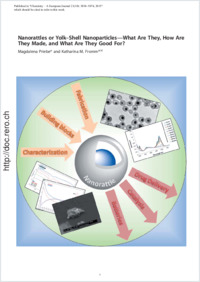Nanorattles or yolk–shell nanoparticles—what are they, how are they made, and what are they good for?
- Priebe, Magdalena Chemistry Department, University of Fribourg, Switzerland
- Fromm, Katharina M. Chemistry Department, University of Fribourg, Switzerland
-
02.03.2015
Published in:
- Chemistry - A European Journal. - 2015, vol. 21, no. 10, p. 3854–3874
English
The development of nanotechnology has led to the design of cutting-edge nanomaterials with increasing levels of complexity. Although “traditional” solid, uniform nanoparticles are still the most frequently reported structures, new generations of nanoparticles have been constantly emerging over the last several decades. The outcome of this nano-art extends beyond nanomaterials with alternative compositions and/or morphologies. The current state-of-the-art allows for the design of nanostructures composed of different building blocks that exhibit diverse properties. Furthermore, those properties can be a reflection of either individual features, which are characteristic of a particular building block alone, and/or synergistic effects resulting from interactions between building blocks. Therefore, the unique structures as well as the outstanding properties of nanorattles have attracted increasing attention for possible biomedical and industrial applications. Although these nanoparticles resemble core–shell particles, they have a distinctive feature, which is a presence of a void that provides a homogenous environment for the encapsulated core. In this Review, we give a comprehensive insight into the fabrication of nanorattles. A special emphasis is put on the choice of building blocks as well as the choice of preparation method, because those two aspects further influence properties and thus possible future applications, which will also be discussed.
- Faculty
- Faculté des sciences et de médecine
- Department
- Département de Chimie
- Language
-
- English
- Classification
- Chemistry
- License
-
License undefined
- Identifiers
-
- RERO DOC 257156
- DOI 10.1002/chem.201405285
- Persistent URL
- https://folia.unifr.ch/unifr/documents/304375
Statistics
Document views: 172
File downloads:
- pdf: 410
